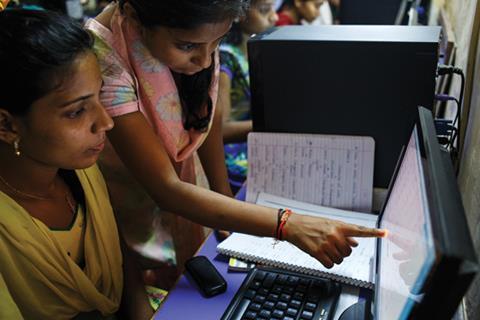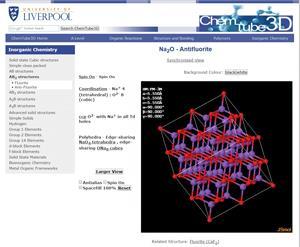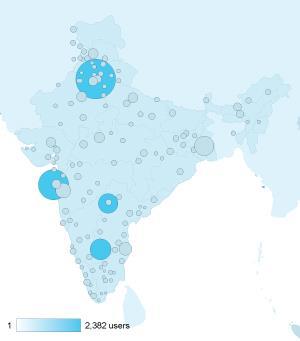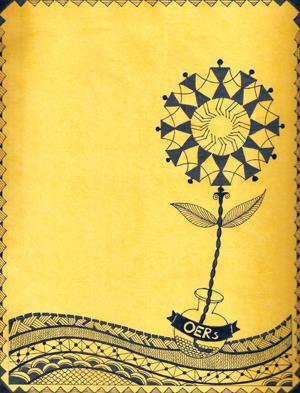Both countries could benefit from embracing fully the open education movement, say Tejas Joshi and Simon Lancaster
The parallels between the Indian and English education systems are striking and reflect 200 years of shared history.1 Central and state boards in India define and administer the stages of education from primary (the education of students aged 6–14) to secondary (students aged 14–18). Meanwhile, secondary education incorporates the ‘+2’ or higher secondary, which like the UK’s A-level, represents the entry qualification for higher education courses, typically three year degree courses.

India, however, does not share the UK’s reputation for higher education. This is something the country is keen to remedy, and policymakers are paying particular attention to the sciences, as evidenced by the establishment of dedicated institutions like the Indian Institutes of Science Education and Research (IISERs) and innovation in the design of undergraduate programmes. A pure science pathway in India following the higher secondary examination can be pursued at the central or state universities (or colleges affiliated to them) that offer the three year bachelor of science (BSc) programme, or at any of the IISERs or the Indian Institutes of Technology (IITs) that have a five year integrated master’s programme, or the Indian Institute of Science that has a four year undergraduate programme.
Unfortunately, chemistry lags behind other subjects in terms of popularity. Amidst rampant economic growth, applied fields such as engineering and medicine are perceived as ‘lucrative’ and ‘respectable’, while a chemistry or science career is often regarded as the last resort. The issues might manifest differently between urban and rural environments, and depend upon the type of institution, but the challenges are essentially national.
So, with the challenges for chemistry education being the same in India as they are in the UK, how do we present chemistry as the central source of solutions to the challenges facing humanity in the 21st century? How do we ensure high quality resources are readily available to a diverse and often disadvantaged population? In both societies, much needs to be done to invigorate the teaching and learning process for those that enrol onto science courses.
We strongly believe many of the answers are to be found in the open education movement.
Appreciating open education
A term like ‘open educational resources’ (OERs) is inevitably going to have a plethora of working definitions. The Organisation for Economic Co-operation and Development suggests: ‘digitised materials offered freely and openly for educators, students, and self-learners to use and reuse for teaching, learning, and research. [The term] OER includes learning content, software tools to develop, use, and distribute content, and implementation resources such as open licences’.2


There is a broader definition of ‘open educational practice’ from the Cape Town Open Education Declaration, a founding text of the OER movement: ‘open education is not limited to just open educational resources. It also draws upon open technologies that facilitate collaborative, flexible learning and the open sharing of teaching practices that empower educators to benefit from the best ideas of their colleagues. It may also grow to include new approaches to assessment, accreditation and collaborative learning.’3
Learn Chemistry and ChemTube3D
Internationally, there are many examples of chemistry OERs. Wikipedia itself contains a vast array of generally good chemistry articles and is often the first stop for the Google-directed student. Furthermore, readers of Education in Chemistry will doubtless find something of interest on the Expertise in Chemical Education ECTN database.4
The RSC has been working extensively with Indian teacher training partners funded by philanthropic donations from Yusuf Hamied,5 the former chairman of Indian generics giant Cipla. The community has been encouraged to use the extensive and ever-expanding tools on the RSC Learn Chemistry website.6 Learn Chemistry is a repository for chemistry teaching resources across all ages and education levels. It is notable that, at the time of writing this, it does not include any Indian-authored OERs.
One of the most successful UK chemistry OERs is ChemTube3D, an online collection of interactive, 3D animations and structures relating to undergraduate chemistry. Its creator, Nick Greeves, received the 2015 Nyholm education award in recognition for his success in this area. The online traffic for ChemTube3D serves as a proxy for the demand for international OERs in India. In the last year, it increased by 62% overall and by 217% in the hotspot of Delhi.
Indian chemistry open educational resources
In the past decade, government departments of education, institutions of higher education such as the Indian Institutes of Technology and smaller, individual-scale projects have undertaken a range of chemistry-related OER initiatives in India. Given the need, most of the OER projects in India cater for the secondary education sector.
Arguably the highest profile among the Indian higher education OERs is the National Programme on Technology Enhanced Learning (NPTEL). The programme is supported by the Ministry of Human Resource Development (MHRD) and jointly run by the Indian Institutes of Technology and the Indian Institute of Science. It is pitched at higher education, and provides a suite of e-learning resources in the form of video lectures and study materials. There are collections on engineering, science and humanities, and in the chemistry collection alone nearly 60 items have been made available.7 Materials include entire modules, lecture slides and assignments. The NPTEL YouTube channel has over 400,000 subscribers. The programme makes a compelling Indian-focused example of the potential of OER projects and the vast, receptive user-base.

In the National Science Digital Library (NSDL),8 a project of the Council of Scientific and Industrial Research (CSIR), the focus is also on compiling curriculum based content for undergraduates. The digital library includes chapters and books on science, engineering and technology. The indexing system is excellent, enhancing the value of the collection and in keeping with the library ethos.
The case for open educational resources
Helen Beetham and colleagues have identified a number of advantages of embracing open education practices.13 The benefits of open educational resources can be broken down into groups.
Benefits to students
- Students can learn in the field or on placement through open practices
- Students are introduced to a wider range of ideas, examples and approaches than they would be through a closed course
- The wider trend is towards openness and as such supporting the practice better equips students to deal with the challenges of the future
- OERs allow students to dip in and out of topics making it easier for them to make informed choices about their study options
Benefits to chemists and chemistry teachers
- OERs offer teachers the freedom to recommend to students the best learning resources
- Teachers with an interest in pedagogy can connect with more learners online
- Individual chemists can enhance their (digital) reputation, and by extension that of their institution, by showcasing their practice
- Openness encourages work at the interfaces between institutions and departments
Benefits to the school or department
- The learning experience offered by the school or department is promoted to prospective students
- Prospective members of staff and partners may well be attracted to a forward-looking approach and general openness
- Open access to research and teaching materials can contribute to research impact and thereby enhance the reputation of a school or department
- OERs can extend the international reach of a school or department
- Openness enhances the legal, technical and educational capacity to address current and future digital literacy needs
Benefits to the community
- Pooling of knowledge and tools through academic communities benefits all members of those communities. Open content projects are increasingly supported and enhanced by open peer review and open commentary. The RSC initiative Learn Chemistry is a good example of this
- The community approach is sustainable at scale and requires less financial risk than closed approaches
NPTEL is complemented by the National Repository for Open Educational Resources (NROER).9 NROER includes a variety of multimedia resources including videos, audio files, interactive tasks built on applets and images. The National Council of Educational Research and Training (NCERT) is responsible for publishing the standard textbooks for school education from classes 1–12 of the Central Board of Secondary Education (CBSE). NCERT has acted to make the textbooks and syllabuses for these classes freely available online.10
Based in Mumbai, the Homi Bhabha Centre for Science Education (HBCSE) addresses science, mathematics and technology education at primary to higher education levels. The centre has been a pioneering contributor to Indian OER projects.11 While on placement at HBCSE, we developed complementary digital and print resources on the elements and the periodic table,12 and during the development of the associated web portal, we took the opportunity to link to an array of relevant open access resources. This act of aggregation and critical assessment not only provided a valuable resource to the teacher learner community, but also served as an exemplar of the professional judgement at the heart of OER adoption.
Final thoughts

When assessing innovative educational practices, there is always a danger of making a judgement based entirely on the first example encountered. We know enough not to despair of all textbooks, and of ever authoring one, when we encounter a poorly written example, and the same should apply to chemistry OERs. To ensure the global success of the open education movement, we need to direct efforts to inform and train educators in the process of OER selection, utilisation and development. In both the UK and India, the open education movement is immature and not fully understood. The area of open source licensing (of which creative commons is the most widely used) is one where particular effort needs to be made.
Our experience of sharing Learn Chemistry with chemistry educators in the Mumbai and Bangalore regions and the national success of ChemTube3D demonstrate that the appetite for high quality OERs exists. Uptake for science courses is increasing rapidly (with more than 3 million students at any one time as of 2013), and thus the scope for expansion of teaching resources – indeed, the need for expansion – is considerable.
The relationship between chemistry education in the UK and India is defined more by our similarities than our differences. We should normalise the mutually beneficial open exchange of educational resources. Given the close relationship between the two countries, the prominence of the Royal Society of Chemistry in India and the quality of Indian chemical education, it will not be long before Learn Chemistry provides a global showcase for Indian-authored OERs. However, without providing educators with the knowledge, trust and freedom required to make the best use of OERs, both countries will fail to fully benefit from the advantages of global open chemistry education.
Tejas Joshi is a visiting student at the Homi Bhabha Centre for Science Education, India. Simon Lancaster is a professor of chemical education at the University of East Anglia, UK.
References
5.Education in Chemistry, March 2015
6.http://rsc.li/learn-chemistry
13.H Beetham et al, Open practices: briefing paper. JISC, 2012









No comments yet